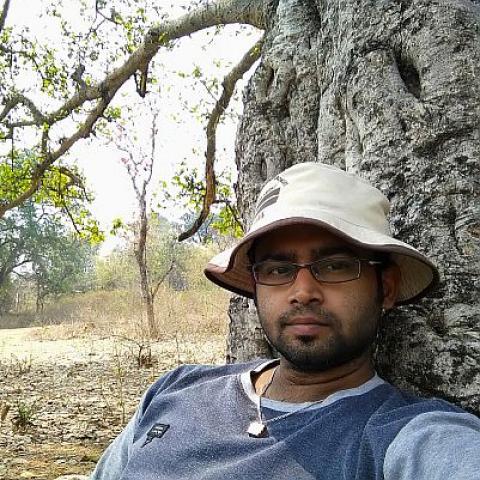Abhijit Dey
Though I did my bachelors in Electrical Engineering, and worked in the corporate sector for years - I always wanted to do what I'm doing now - working for the conservation of nature. It was not an easy task to jump from one field to another which is completely unrelated, but I'm glad that I've made it, and been able to join the cohort of many others like me. During my corporate days, I engaged myself with multiple conservation-based research projects. This of course equipped me to steer myself toward this field. While doing my MSc from Pondicherry University in Ecology and Environmental Sciences, I executed a couple of short-spanned research works on birds, plant-insect interaction, and spiders. Also, at this time, we (me and a few like-minded friends) took on outreach activities to spread awareness, and talk about environmental issues. I continued the same as a naturalist for a short while after my MSc and before joining the PhD program at ATREE.
The title of my PhD work is - The Mahua Regeneration Conundrum: Analyzing Interactive Effects of Seed Harvest, Land Cover Changes in Mahua (Madhuca Longifolia) Population Maintenance, and Other Socioeconomic Processes Behind it.
Mahua is a dominant tree species of Tropical Dry Deciduous Forests of India. It’s crucial for the functioning of these forest ecosystems. Mahua is also an integral part of the lives of the indigenous communities of these forests. Around 7.5 million tribals in central and eastern India are engaged in the mahua collection. It is a significant component of their livelihood, of their cultural identity. The population of such an important species is declining and I want to know why.
On the other hand, the dry forests of Chota Nagpur Plateau of eastern India are biodiversity-rich, home to several threatened species like striped hyena, Indian grey wolf, pangolin, elephant, etc. So, to investigate the ‘Mahua Regeneration Conundrum’, I decided to work in this important landscape, which is virtually unexplored socio-ecologically and requires urgent conservation attention. Broadly, my purpose is the conservation of this fine yet unrecognized landscape through the question of all-important ‘kalpavriksh’ mahua.
For my PhD work, specifically, I am looking into this: three things are prerequisites for regeneration to be successful – availability of seeds, their dispersion, and where it is dispersed. My first objective is to understand the nitty-gritty of seed harvesting practices and the socioeconomic drivers behind them. Second, if harvesting of seeds impacts the seed dispersion by its dispersers i.e. fruit-bats. Third, how is the mahua population performing in different land cover types, and that is also a factor for the mahua population decline? In short, taking a holistic measure to understand the mahua ecology in its habitat where humans are an integral part of it.
Popular articles
Yet to have any academic publications, but I try to share my experiences, and stories on various topics on different web portals.
Kadwi Hawa to Kantara: How Indian Cinema Championed the Fight Against Climate Change, The Better India, Jan 2023
Can mahua seeds provide Adivasis a reliable livelihood? Down To Earth, Dec 2022
Kantara: a triumph for Indigenous Knowledge System, Counter Currents, Nov 2022
My Space: When Lynx Spiders Find Their Niche, Round Glass Sustain, Nov 2022
The Art of Getting-by – COVID-19 and Self-reliance. Vikalp Sangam, Jan 29, 2022
Merry-go-round Around and Around! Youth for Nature, Mar 15, 2021
The Rescue Mission. Current Conservation, Oct 7, 2020
‘Garh’, Mahua, its people, and a few questions. AYRN Stories, Jan 29, 2020
Run Stupid, Run! Science Outside, Sept 27, 2019
Grants
IdeaWild Equipment Grant (2022)
Rufford Small Grant (2022)
